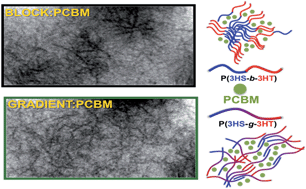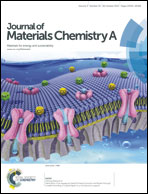An all-conjugated gradient copolymer approach for morphological control of polymer solar cells†
Abstract
This work introduces fully π-conjugated gradient copolymers as promising materials to control and stabilize the nanoscale morphology of polymer:fullerene solar cells. Gradient and block sequence copolymers of 3-hexylselenophene (3HS) and 3-hexylthiophene (3HT) are utilized as the donors (D) in bulk-heterojunction (BHJ) solar cells with phenyl-C61-butyric acid methyl ester (PCBM) as the acceptor (A). We show that for the same overall copolymer composition, the ordering of molecular constituents along the copolymer chain (copolymer sequence) significantly influences the nanoscale morphology and phase separation behavior of π-conjugated copolymer:fullerene devices. In addition, energy-filtered transmission electron microscopy (EFTEM) of the blends revealed that relative to the block copolymer:PCBM, the gradient copolymer:PCBM sample formed a more uniform, continuous and interconnected network of polymer fibrils within the acceptor-rich phase, associated with a large D/A interface. Charge extraction of photogenerated carriers by linearly increasing voltage (photo-CELIV) shows that the gradient copolymer:PCBM device possesses the highest initial carrier density, n(0) = (3.92 ± 0.3) × 1018 cm−3, consistent with a larger D/A interfacial area suggested by the observed morphology, albeit at the expense of increased carrier recombination rate. Accelerated degradation studies show that the gradient copolymer:PCBM system maintains the highest efficiency over prolonged heat treatment.

- This article is part of the themed collection: 2015 Journal of Materials Chemistry A Hot Papers

 Please wait while we load your content...
Please wait while we load your content...